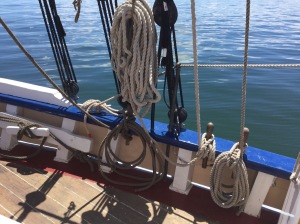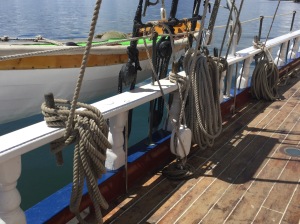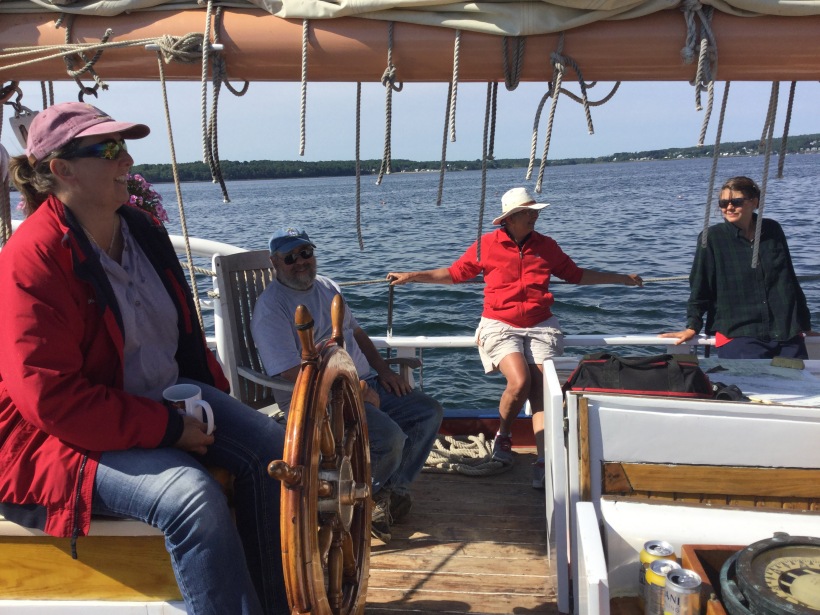Most likely you’ve all heard the phrase “Learning the ropes” – meaning someone is new in a task or job, and is learning how everything works and where everything goes. But possibly many of you don’t know the origin of that saying. Like so many, it’s origin is nautical.
Sailing vessels have lines. LOTS of lines. (As an aside, there are very few “ropes” on a boat. Except in the case of this one phrase, they are nearly all properly referred to as “lines” – please don’t ask me why, as I may start to whimper softly…)
Naturally the larger and the more complex the vessel, the more lines she’ll have, both to hold everything up and together, and to control the rig, sails, ground tackle, etc. How many?A veritable forest!
Now the interesting thing about a traditionally rigged schooner like the Isaac H. Evans (on which vessel Nicki and I are serving as relief crew this summer) is that there’s a line for darn near everything you can imagine. Because of her age, (she was built in 1886) there are very few cables, (called “wire rope” in sailing boats). My mental inventory counts just 22 of them, but a mind-boggling plethora of lines to hold everything together and make it move. I’m not going to try to count – trust me, there are hundreds.
This photo at left gives an idea. This is the starboard fore-mast rail. Those black lines in multiples of 6 are the dead-eyes and lanyards that apply tension to each of the three stays (or shrouds) which hold the foremast up, keeping it from bending
to port as we’re sailing with the wind on the starboard (right) side of the boat. The shrouds themselves are wire, everything else is wood or line.
To the right, we have the starboard mainmast rail. You can see the dead-eye and lanyard sets, and below that, the pinrail (built into the boat’s rail, in this case. Sometimes it’s separate.)
The first line (left in this photo) is the centerboard line, made off on it’s pin. The next back is the Mains’l peak halyard, the Mains’l lazyjack, another I’m not sure of (I’m still learning the ropes!), and farthest aft, the “Bit”.
Still with me? I hope so, because there are four stations like this on the Evans (being a two-masted schooner), they all look this complicated, and NOTHING IS LABELED! Well, almost.
I was into my 8th day working aboard when I suddenly realized that the halyards for the main, fores’l and main-tops’l are always made off to pins that are made of bronze. And those are the only bronze pins on the boat. A light came on!
Though the light isn’t great in this picture of the port foremast rail, you can about make out that the far-left (aft) pin is dark wood, the one next to it (with darker line attached) is bronze, the next is reddish wood (I’m guessing red oak?), and the one after that is stained dark – perhaps white oak? I’m starting to see a pattern.
Oh, and all those lines? Here’s my test! Left to right, they are: I don’t know yet; Foremast peak halyard; Stays’l halyard; Bailey; and finally port lifeline (on the cleat). That large line lying on deck to the far right of the photo is the port jib sheet.
The reward for all this new knowledge is, of course, the chance to be part of the team that makes her go and keeps her sound. That’s owner and Captain Brenda “Cappy” Thomas at the wheel, former owner and fix-it man extraordinaire Captain Ed Glaser, accomplished sailor and friend Meriel, and First Mate of the highest order, Autumn Simpson, here relaxing under sail after what was – honestly, a bit of a tense morning, equipment-wise.
For Nicki & me, it’s fun and challenging and interesting to be back in a “Crew” position after spending 8 1/2 months aboard our own boat, very much in “Captain & Owner” mode. We do what we’re told as best we can, ask a ton of questions, and jump when we’re told to jump – even at 2:15am…
But that’s a story for a different day.






July 3, 2017 at 9:08 am
Just letting you know I’m still reading. Great writing. Very enjoyable.
Bruce Pratt
s/v Willow
Oriental, N C
LikeLiked by 1 person
July 3, 2017 at 11:12 am
Thanks Bruce! I appreciate that. Sometimes it does kinda feel like shouting down a well…
LikeLike
July 3, 2017 at 9:23 am
Please, no whimpering! But I’m guessing that your schooner has at least three, possibly four ropes, if not more – one of which is shown in your photos. Your mission, should you choose to accept it…
LikeLiked by 1 person
July 3, 2017 at 11:20 am
Haven’t met a rope yet, I’m afraid. Unless you count the wire rope?
LikeLike
July 3, 2017 at 7:30 pm
Ah, well, then, allow me to introduce you to the bolt rope – visible in your first pic: the reinforcing rope attached to the perimeter of the sail… you may not have come in contact with this one at this point in your traditional sailing career.
If you’ve been out on the bowsprit furling headsails, you’ve probably stood on a foot rope, which is… well, the rope you stand on! I can think of a couple more you *might* come across, especially if you’re working, and not a passenger…
To be fair, these are all sort of secondary and none are part of the sexy running rigging which most people like to get their hands on…
Have fun you guys!!!!
LikeLiked by 1 person
July 3, 2017 at 7:44 pm
Well yes! Actually I confess I was concentrated on standing & running rigging when I wrote that, but yes, bolt ropes are everywhere aboard! We’ve also got a bellrope, but no foot-ropes, as her bowsprit and jib- rigging is all chain and wire.
LikeLike
July 6, 2017 at 8:05 pm
Matt, we’ve learned a lot in the last week, ever since I posted this! It caused a storm of comments on my Facebook page.
Thus far we’ve determined that I was dead wrong on at least four counts! The Evens has:
Bolt Rope.
Bell Rope,
Bucket Rope, and
Man Rope.
No Foot rope, though – we walk on the bob stay and whisker stays instead.
Thanks for precipitating my learning experiences!
LikeLike
July 4, 2017 at 4:30 am
Foot ropes made of wire – fair enough! If you’ve done any salt-water deck washdowns, I imagine you’ve handled a bucket rope, too… ;^)
LikeLiked by 1 person
July 5, 2017 at 10:44 pm
Keith, Do you know the length of your mast? Just curious. I finally got the mast back on our boat today. It measures 40′ in length. I was wondering if they put a taller mast on my boat as it is rigged as a sloop. The mast on my boat is also located about 2 ft further astern then yours. I have a removable solent stay also. I had 130 genoa on a roller furler on the forstay like your setup but I have removed the the furler for maintenance. I’d like to hear your opinion on how you like that setup on your boat. Something that bugs me about the handling characteristics on my boat is that in fairly light air I can not just fly the 130 and be able to steer the boat very well. The issue seems to be that you need quite a bit of water going over that small rudder to pull the nose of the boat into the wind. So your stuck with a paralyzing lee helm unless you have enough wind so the boat is moving along quite well. I suppose if I had a centerboard in the boat this would act as a pivot, but the motorsailer version does not have a board. Anyway, I was wondering if you have experienced this issue? I can put the main up to help with the balance and some speed but I am often sailing alone and just going out for a quick sail after work and I get lazy. I have been considering moving the furler onto the solent stay and putting a 110 jib on. My boat seems better balanced flying a sail off that then the forstay. Also keeps the center of gravity down lower. I usually keep the solent stay clipped on and unclip it when I go sailing. Which is a pain. I did have it tied off to the side but it seems difficult to keep it from slapping or rubbing somewhere which bothers me at anchor. Then on the forstay another furler with a 150 jenny that just goes out in light air….of course you would have to roll it up to tack and then let it back out once through the wind. Well not sure what I will do, my 130 has a big rip along the sunbrella from the hurricane so this would be the time to make changes if I wanted to.
LikeLiked by 1 person
July 6, 2017 at 8:01 pm
Hey Chris! Let’s see – Sionna is 40.6′ from waterline to the tip of her jewelry- er… – VHF antenna. That means to the top of the mast is about 38 feet, and guessing that the hull is four or five feet from waterline to the base of the mast, my mast must be 33 or 34 feet. (Yes, I measured it once, but I can’t remember now…)
So your mast is significantly longer than ours with the ketch rig, yes.
Which is odd, because true motor sailers generally have a shorter rig than their sailing versions, which stands to reason. Maybe someone modified it later? I don’t remember if you’ve said – is your boat a factory finished version, or was it one of the few kits that actually were finished and launched? On a kit boat, anything could have been done, according to the whims of the builder!
I’m not surprised you’re not able to run under just headsail in light winds – Sionna has had her rudder enlarged by the prior owner, which helps, but even so, she’s not happy above a close reach with just the headsail. We run “Jib & Jigger” (Genoa & Mizzen) in moderate winds, where she balances quite well, but don’t run just the Genny unless we’re mostly downwind, as she doesn’t balance well. In the ketch rig, the mizzen really doesn’t add much in the way of power. It’s all about balancing the helm. That, of course, reduces rudder deflection, and so reduces drag and increases speed, but the added sail area is minimal in terms of power.
The centerboard does seem to help in reducing the amount of lee helm somewhat, so I suspect you’re correct that the lack of a board may be adding to your issues in light winds, but I fear you may be stuck with needing at least some main for balance if you want good helm response. Our approach to that is to raise the main first with the sheet free, while were still at anchor or on the mooring. The boat won’t go anywhere if the sheet is free. Now get the rest of the anchor rode up – or drop the mooring – return to the helm, unfurl the headsail when she hunts to the desired tack, and sail off. To re-moor or anchor, reverse the process, but it’s very important that the mainsheet be free to run out all the way, or she will take you for a ride!
You’re also on the right track with the stays’l. Having the center of effort lower and closer to the middle of the boat (and so, closer to the center of resistance of the keel) will reduce the force required of the rudder, and may give you the maneuverability you’re looking for – your boat will be different than Sionna since you have a very different rig. For us, our stays’l on the Solent stay isn’t big enough to move the boat on its own – it’s really a storm jib, about 90 square feet. Tiny. Works very well in winds of 25 knots and higher!
Good luck with your quest for the perfect set-up for each set of conditions. It’s what sailing is all about!
LikeLike
July 18, 2017 at 10:31 am
Ok well I do not know why they put a larger mast on this boat. It is not an easy boat to sail as the only steering is inside. I do not get the impression previous owners ever sailed it much. It is something I have been working on improving. I suppose it is a custom boat there is no reference to this style in a brochure. The one other motorsailer I have seen did not look like my boat but did match the advertising triangle put out on the motorsailer model. While it appears that some things like the cockpit were probably redone the overall feel of the interior wood work is that it was all done originally in 64. My guess is the original owner just specified some changes and the boat wrights at triangle did the work. I do not know, were there kit boats? I have not come across other boats that are different. We are going back so long now that the info has been lost. Almost everyone from that time is dead. I did see a triangle 40 come through Fernandina last year. I went out on the boat and took a tour of it, very interesting. I snapped a photo of her on the mooring if you have an interest.
LikeLiked by 1 person
August 1, 2017 at 7:05 am
I’ve heard/read that there were some boats that were delivered as kits, perhaps as many as 15-20? If they followed the usual pattern of kit-boats, the vast majority of those would never have been finished – perhaps 3 or five might have been? You could have one of those. The only reason we know ours is hull #11 is from the documentation papers, but we take it on faith that the original application for documentation was correct.
Curiously, there is another Triangle 32 on the hard in the boat yard where we stored “Sionna”. Looks like the basic ketch rigged boat, but someone has (poorly) added a pilot house over the cockpit. It’s in pretty rough shape, and the young couple that just bought it have no experience with restoration projects, so I’m not optimistic about her chances of seeing the water again… Pity when good old boats are neglected like that.
In your case, it’s possible someone lost a rig, no replaced it with what they could find/afford? Or perhaps they deliberately changed to a taller rig to improve her sailing performance? The stock Triangles aren’t known as hot rods, particularly in light winds. 🙂
LikeLike